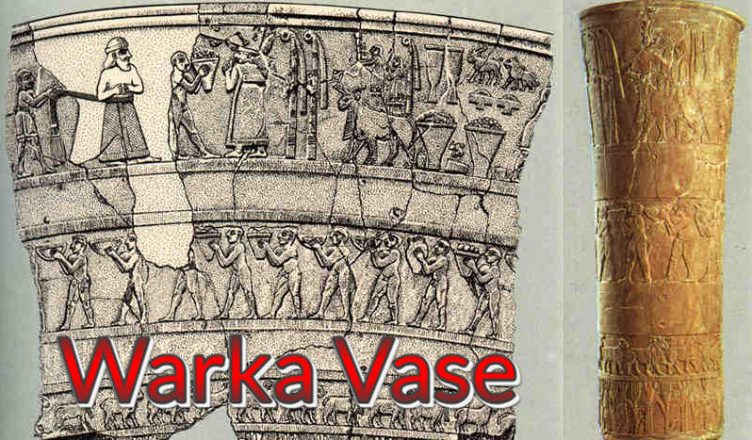The treasure of the Iraq Museum is none other than the Warka Vase. Compared to contemporaneous exhibits like the Uruk Stone Trough, the Warka Vase stands out with its more vivid and lifelike portrayal, evoking a sense of realism and nature. This stone vase is an early Sumerian artifact crafted by Uruk artisans, presented by the king of Uruk as an offering to the gods. Its vivid depiction traces the development from basic city-state agriculture to a relatively advanced state of animal husbandry. It also reflects the societal progression into a structured hierarchy with distinct social levels and relationships. During the Uruk period (circa 4000 to 3000 BCE, named after the Sumerian city of Uruk), the ancient Near East witnessed significant innovations and inventions. One such innovation was the use of art to illustrate the roles of rulers and their status in society. The Warka Vase, discovered in Uruk (modern name for Warka), is arguably one of the most famous examples of this innovation.
Made of alabaster gypsum, standing about one meter tall, and weighing around 270 kilograms, the vase was unearthed in 1934 by German excavators working in the temple of the goddess Inanna in Uruk. Inanna was the love, fertility, and war goddess of Uruk. The vase was part of a pair and other valuable items found within the complex of the Inanna temple.
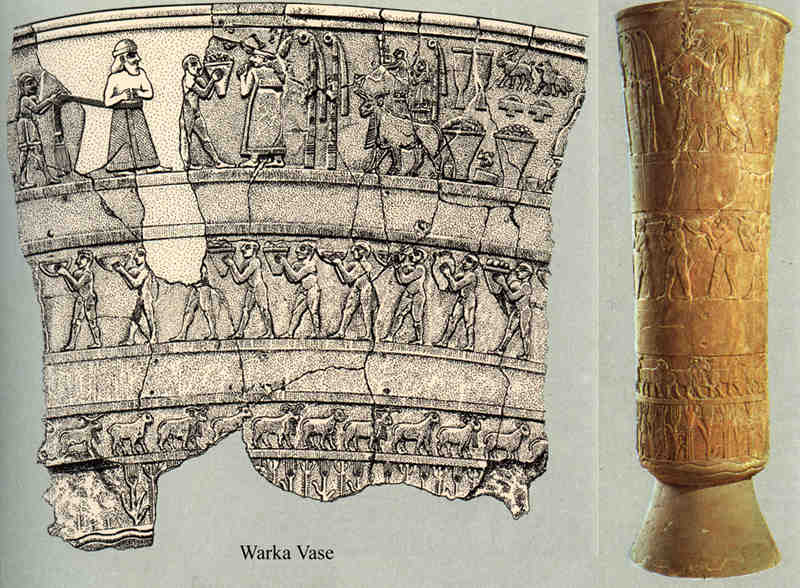
Unveiling Ancient Narratives: The Warka Vase of Uruk’s Rich Legacy
The Warka Vase, also known as the Uruk Vase, is a finely carved alabaster vessel discovered in the temple complex of the Sumerian goddess Inanna within the ruins of the ancient city of Uruk in southern Iraq. Dated to approximately 3200–3000 BC, it stands as one of the earliest examples of narrative relief sculpture, akin to the Uruk Trough and the Narmer Palette from Egypt. The vase’s bottom register intricately portrays naturalistic elements of life, including water and various plants, while the middle register features naked men carrying baskets of foodstuffs symbolizing offerings. The top register depicts the goddess Inanna accepting a votive offer, possibly illustrating a ritual marriage with her consort Dumuzi, ensuring Uruk’s prosperity. The vase was unearthed in 1933/1934 during the sixth excavation season at Uruk by German Assyriologists. Recorded as find number W14873, the vase, made of alabaster and standing around 96 cm tall (or possibly 106 cm according to some sources), showed signs of ancient repairs. It was discovered in fragments, and its detailed depiction of societal and natural hierarchies, as noted by anthropologist Susan Pollock, adds significant historical insight. Named after the modern village of Warka, the vase has played a pivotal role in understanding the cultural and ritual practices of ancient Mesopotamia. A plaster cast of the original has been on display for many years at the Near-Eastern Museum in Berlin, Germany.
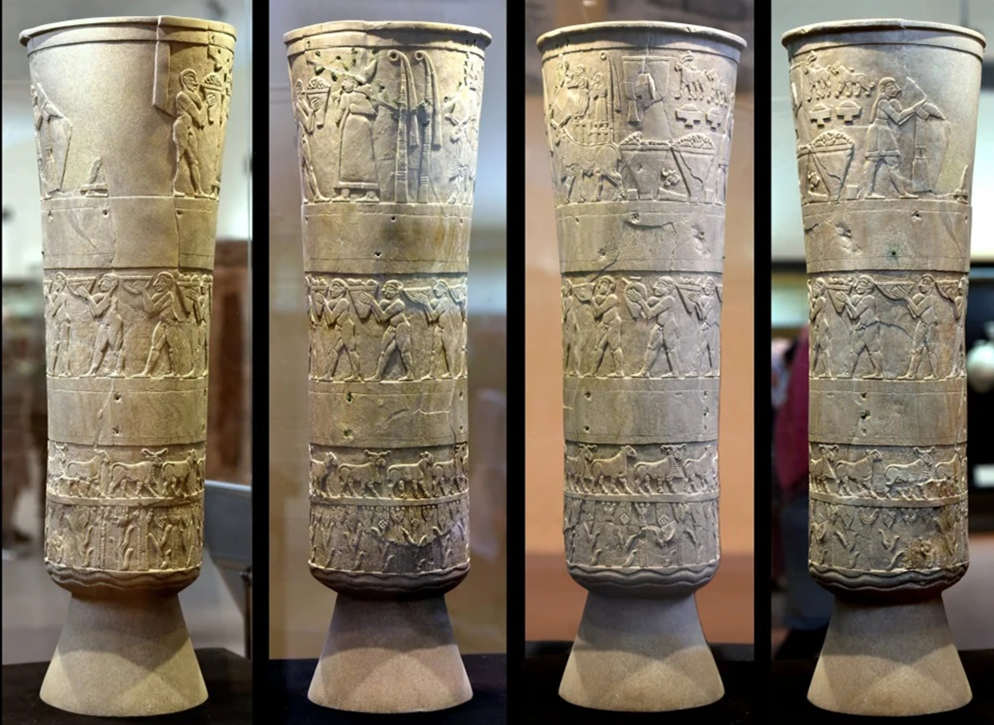
The Intricate Details of the Warka Vase Depicting Mesopotamian Life and Rituals
The Warka Vase is adorned with three distinct registers, each revealing intricate details of Mesopotamian life and rituals. The bottom register meticulously portrays the lush vegetation of the Tigris and Euphrates delta, featuring natural reeds and cultivated grains. Above this, the second register presents a procession of animals, including rams and sheep, showcased in a precise profile view. Continuing the procession, the third register unveils a scene rather than a continuous pattern. Here, the procession concludes at the temple area, where the chief goddess Inanna, later known as Ishtar, stands with two bundles of reeds behind her. In a symbolic gesture, a nude figure offers her a bowl of fruit and grain, while the en of Uruk, adorned in ceremonial attire, leads the procession, emphasizing the rich cultural and ritualistic significance embedded in the vase’s intricate decorations.
various details of the Warka Vase
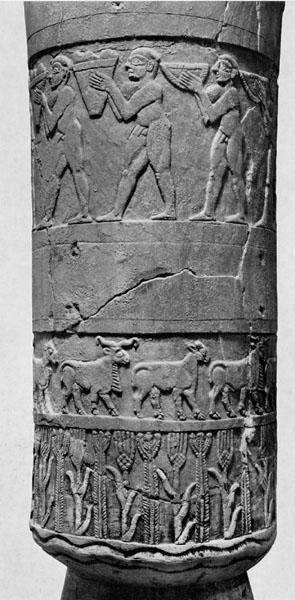
1. Details of the Vase Base
Given the immense size, precious materials used in its carving, and the complexity of its relief decoration, the Uruk Vase evidently holds enduring significance, deserving admiration and attention. The relief on the exterior of the vase extends in four parallel bands around its circumference, gradually becoming more intricate from bottom to top.
Starting from the base, a pair of undulating lines alternately give rise to what appears to be plants resembling grains (possibly barley) and reeds. These represent the two most important agricultural harvests of southern Mesopotamia, the Tigris and Euphrates rivers. The alternating pattern has a satisfying rhythm, echoing the rhythm of alternating bands above depicting rams and ewes (male and female sheep). The sheep move closely in formation to the right, reminiscent of the method of tending to this crucial livestock in the agricultural economy of the Uruk period.
Above the bands of sheep, there is a blank space, likely once adorned with now-lost painted decorations. Above this blank band, a group of nine identical figures marches to the left. Each figure holds a vessel, seemingly containing products of the Mesopotamian agricultural system: fruits, grains, wine, and honeyed wine. The men are muscular, much like the sheep beneath them, tightly and evenly grouped, creating a rhythmic sense of activity. In ancient Near Eastern art, nude figures were understood as humble and low-status, leading us to assume these individuals to be servants or slaves.
The uppermost register of the vase is the largest and most intricate, though it has suffered some damage, it still provides insights into the scene. The center of the scene appears to depict a face-to-face encounter between a man and a woman. A smaller-sized man stands between them, holding a container containing what seems to be agricultural produce. The woman’s long robe and flowing hair signify her identity, and she likely wore an elegant crown (broken and restored in antiquity).
Behind her are two bundles of reeds, symbolizing the goddess Inanna, presumably representing her. The man facing her is almost entirely missing, with only the bottom of his robe remaining. However, in contemporary cylinder seal carvings, figures dressed similarly to the robe have been discovered, allowing us to reconstruct him as a king with a long skirt, beard, and headband. The fringes of his skirt are held by another smaller figure behind him, likely the king’s steward or attendant, wearing a short skirt.
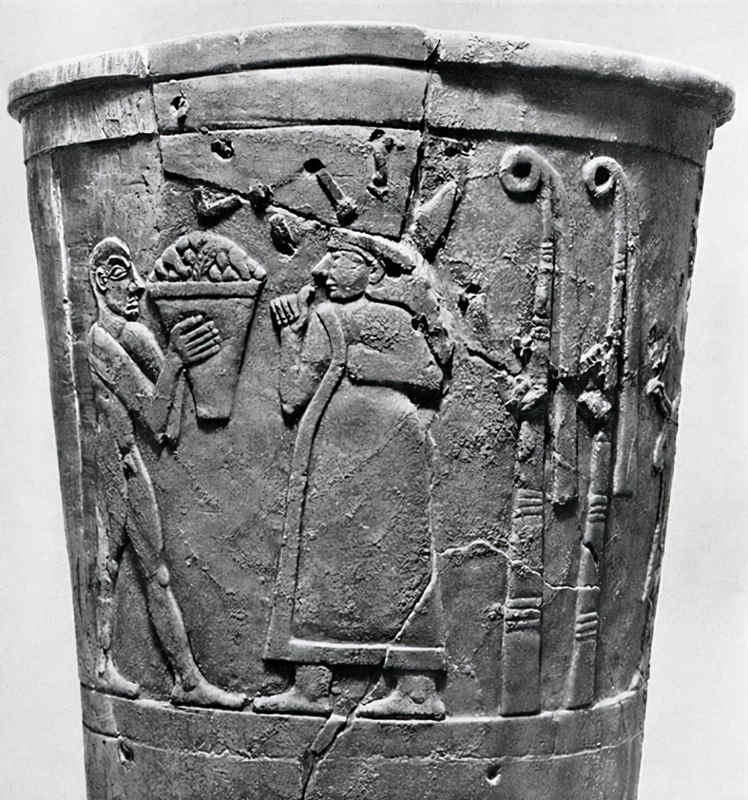
2. Details of the Top Parallel Bands
The remaining part of the scene is situated behind the bundles of reeds behind Inanna. Here, two rams with horns and beards (one directly behind the other, making only the hooves visible for the rear ram) carry a platform with statues standing on top. The statue on the left bears a cuneiform sign for “EN,” signifying the high priest in Sumerian. The statue on the right stands in front of another bundle of Inanna’s reeds. Behind the rams is a series of offerings, including two objects resembling the Uruk Vase.
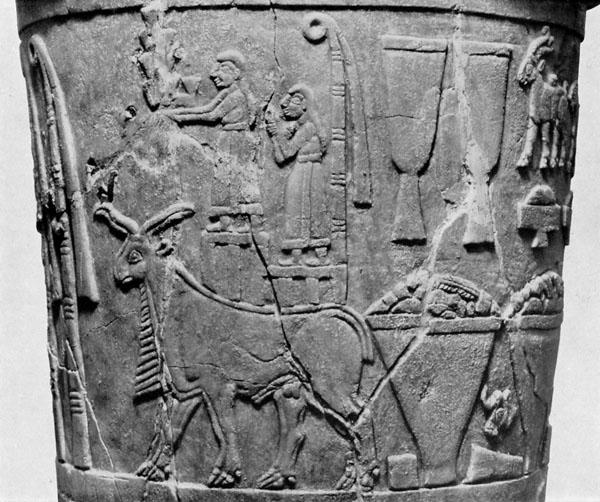
What does this bustling scene signify? The simplest explanation is that a king (likely of Uruk) is celebrating the city’s most important divine protector, the goddess Inanna. A more detailed interpretation of the scene suggests a sacred marriage between the king, serving as the chief priest of the temple, and the goddess – each depicted in both human and statue form. Their union would ensure agricultural prosperity for Uruk, as seen behind the rams. The worship of Inanna dominated the decoration of the vase, and the top illustrates how the king, as the chief priest of the goddess, assumed responsibility for and ownership of the city-state’s agricultural wealth.
4. Discarded Base of the Vase
The Uruk Vase, one of the most important artifacts at the Iraq National Museum in Baghdad, was stolen in April 2003 along with countless other priceless antiquities, a direct consequence of the U.S. invasion of Iraq. The vase was returned in June of the same year due to an amnesty program aimed at encouraging the return of looted items. The Guardian reported that the “U.S. military ignored warnings from its civilian advisers that could have prevented the looting of priceless artefacts in Baghdad.”
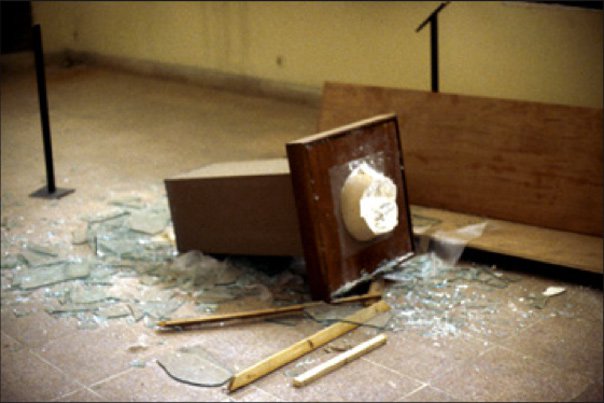
Even before the invasion, looting had become an increasingly serious issue due to economic uncertainty and widespread unemployment following the Gulf War in 1991. According to Dr. Neil Brodie, Senior Research Fellow at the Endangered Archaeology in the Middle East and North Africa project at the University of Oxford, “After that war… as the country descended into chaos, between 1991 and 1994, 11 regional museums were looted, approximately 3,000 objects and 484 manuscripts were stolen.” The majority of these have yet to be returned. Additionally, as Dr. Brodie points out, the most significant issue might be why there hasn’t been consistent international action to prevent the sale of wartime looted items from archaeological sites and cultural institutions.
END:
In conclusion, the Warka Vase, with its three registers of finely carved details depicting scenes from Mesopotamian life and rituals, stands as a timeless testament to the artistic and cultural achievements of ancient Uruk. This remarkable artifact, dating back to approximately 3200–3000 BC, has not only enriched our understanding of the societal and natural hierarchies of that era but has also provided invaluable insights into the religious practices and agricultural customs of Mesopotamia.
The impact of the Warka Vase extends beyond its historical significance, reaching into the realm of archaeology and inspiring subsequent generations of researchers. Its meticulous carvings and narrative reliefs have fueled scholarly discussions, prompting further exploration and analysis. The vase’s portrayal of the ritual marriage between the goddess Inanna and Dumuzi, as well as its depiction of societal structures, has become a focal point for understanding the complexities of ancient Mesopotamian civilizations.
Moreover, the Warka Vase has served as a source of inspiration, inviting contemplation on the interconnectedness of art, culture, and human history. Its influence on subsequent archaeological studies has been profound, shaping the methodologies and perspectives of researchers seeking to unravel the mysteries of our shared past. As we continue to unearth the remnants of ancient civilizations, the Warka Vase remains a beacon, guiding scholars and enthusiasts alike in their quest to unravel the tapestry of human history and cultural evolution.
More UFOs and mysterious files, please check out our YouTube channel: MysFiles
Chelyabinsk meteor event: Did the UFO crush this huge meteor?
